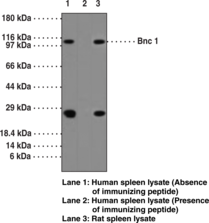Cayman
Showing 12301–12450 of 45550 results
-
BMS-3 is a potent inhibitor of activated LIM domain kinases LIMK1 and LIMK2 (IC50s = 5 and 6 nM, respectively).{32445} It is used to study the role of activated LIMK isoforms in the signaling of Rho family GTPases to cytoskeletal proteins, including cofilin and tubulin.{32443,32444,32446}
Brand:CaymanSKU:-Available on backorder
-
BMS-3 is a potent inhibitor of activated LIM domain kinases LIMK1 and LIMK2 (IC50s = 5 and 6 nM, respectively).{32445} It is used to study the role of activated LIMK isoforms in the signaling of Rho family GTPases to cytoskeletal proteins, including cofilin and tubulin.{32443,32444,32446}
Brand:CaymanSKU:-Available on backorder
-
BMS-5 is a potent inhibitor of activated LIM domain kinases LIMK1 and LIMK2 with IC50 values of 7 and 8 nM, respectively.{32445} LIMK1 and LIMK2 participate in signal pathways affecting actin dynamics by deactivating cofilin.{32443,32444} This compound can be used to study the role of activated LIMK isoforms in the signaling of Rho family GTPases to cytoskeletal proteins, including cofilin.
Brand:CaymanSKU:21072 -Out of stock
-
BMS-5 is a potent inhibitor of activated LIM domain kinases LIMK1 and LIMK2 with IC50 values of 7 and 8 nM, respectively.{32445} LIMK1 and LIMK2 participate in signal pathways affecting actin dynamics by deactivating cofilin.{32443,32444} This compound can be used to study the role of activated LIMK isoforms in the signaling of Rho family GTPases to cytoskeletal proteins, including cofilin.
Brand:CaymanSKU:21072 -Out of stock
-
BMS-5 is a potent inhibitor of activated LIM domain kinases LIMK1 and LIMK2 with IC50 values of 7 and 8 nM, respectively.{32445} LIMK1 and LIMK2 participate in signal pathways affecting actin dynamics by deactivating cofilin.{32443,32444} This compound can be used to study the role of activated LIMK isoforms in the signaling of Rho family GTPases to cytoskeletal proteins, including cofilin.
Brand:CaymanSKU:21072 -Out of stock
-
BMS-536924 is a dual inhibitor of insulin-like growth factor receptor (IGF-1R) kinase and insulin receptor (IC50s = 100 and 73 nM, respectively).{29658} In this way, it blocks IGF-1R autophosphorylation and signaling through MEK1/2 and Akt, leading to G1 arrest and apoptosis in myeloblastic leukemia ML-1 cells. BMS-536924 reverses epithelial-to-mesenchymal transition in immortalized mammary epithelial MCF10A cells overexpressing constitutively activated IGF-1R and causes growth inhibition and polarization of breast cancer MCF-7 cells.{29655,29657} It also induces expression of cytochrome P450 3A4 isoform in primary hepatocytes.{29656}
Brand:CaymanSKU:- -
BMS-536924 is a dual inhibitor of insulin-like growth factor receptor (IGF-1R) kinase and insulin receptor (IC50s = 100 and 73 nM, respectively).{29658} In this way, it blocks IGF-1R autophosphorylation and signaling through MEK1/2 and Akt, leading to G1 arrest and apoptosis in myeloblastic leukemia ML-1 cells. BMS-536924 reverses epithelial-to-mesenchymal transition in immortalized mammary epithelial MCF10A cells overexpressing constitutively activated IGF-1R and causes growth inhibition and polarization of breast cancer MCF-7 cells.{29655,29657} It also induces expression of cytochrome P450 3A4 isoform in primary hepatocytes.{29656}
Brand:CaymanSKU:- -
BMS-536924 is a dual inhibitor of insulin-like growth factor receptor (IGF-1R) kinase and insulin receptor (IC50s = 100 and 73 nM, respectively).{29658} In this way, it blocks IGF-1R autophosphorylation and signaling through MEK1/2 and Akt, leading to G1 arrest and apoptosis in myeloblastic leukemia ML-1 cells. BMS-536924 reverses epithelial-to-mesenchymal transition in immortalized mammary epithelial MCF10A cells overexpressing constitutively activated IGF-1R and causes growth inhibition and polarization of breast cancer MCF-7 cells.{29655,29657} It also induces expression of cytochrome P450 3A4 isoform in primary hepatocytes.{29656}
Brand:CaymanSKU:- -
BMS-536924 is a dual inhibitor of insulin-like growth factor receptor (IGF-1R) kinase and insulin receptor (IC50s = 100 and 73 nM, respectively).{29658} In this way, it blocks IGF-1R autophosphorylation and signaling through MEK1/2 and Akt, leading to G1 arrest and apoptosis in myeloblastic leukemia ML-1 cells. BMS-536924 reverses epithelial-to-mesenchymal transition in immortalized mammary epithelial MCF10A cells overexpressing constitutively activated IGF-1R and causes growth inhibition and polarization of breast cancer MCF-7 cells.{29655,29657} It also induces expression of cytochrome P450 3A4 isoform in primary hepatocytes.{29656}
Brand:CaymanSKU:- -
BMS-777607 is an inhibitor of the Met kinase family. It inhibits Ron, Met, Tyro-3, and AxI with IC50 values of 1.8, 3.9, 4.3, and 1.1 nM, respectively.{29883} At higher concentrations it is reported to inhibit Mer, FLT3, Aurora B, Lck, and VEGFR2 (IC50s = 14, 16, 78, 120, and 180 nM, respectively).{29883} In cancer cells, BMS-777607 induces polyploidy with multiple sets of chromosomes, as well as suppresses metastasis.{29883,29882} In tumor xenograft models, BMS-777607 at 50 mg/kg/mouse inhibits the growth of tumor cells expressing Met/Ron.{29883}
Brand:CaymanSKU:-Available on backorder
-
BMS-777607 is an inhibitor of the Met kinase family. It inhibits Ron, Met, Tyro-3, and AxI with IC50 values of 1.8, 3.9, 4.3, and 1.1 nM, respectively.{29883} At higher concentrations it is reported to inhibit Mer, FLT3, Aurora B, Lck, and VEGFR2 (IC50s = 14, 16, 78, 120, and 180 nM, respectively).{29883} In cancer cells, BMS-777607 induces polyploidy with multiple sets of chromosomes, as well as suppresses metastasis.{29883,29882} In tumor xenograft models, BMS-777607 at 50 mg/kg/mouse inhibits the growth of tumor cells expressing Met/Ron.{29883}
Brand:CaymanSKU:-Available on backorder
-
BMS-777607 is an inhibitor of the Met kinase family. It inhibits Ron, Met, Tyro-3, and AxI with IC50 values of 1.8, 3.9, 4.3, and 1.1 nM, respectively.{29883} At higher concentrations it is reported to inhibit Mer, FLT3, Aurora B, Lck, and VEGFR2 (IC50s = 14, 16, 78, 120, and 180 nM, respectively).{29883} In cancer cells, BMS-777607 induces polyploidy with multiple sets of chromosomes, as well as suppresses metastasis.{29883,29882} In tumor xenograft models, BMS-777607 at 50 mg/kg/mouse inhibits the growth of tumor cells expressing Met/Ron.{29883}
Brand:CaymanSKU:-Available on backorder
-
BMS-777607 is an inhibitor of the Met kinase family. It inhibits Ron, Met, Tyro-3, and AxI with IC50 values of 1.8, 3.9, 4.3, and 1.1 nM, respectively.{29883} At higher concentrations it is reported to inhibit Mer, FLT3, Aurora B, Lck, and VEGFR2 (IC50s = 14, 16, 78, 120, and 180 nM, respectively).{29883} In cancer cells, BMS-777607 induces polyploidy with multiple sets of chromosomes, as well as suppresses metastasis.{29883,29882} In tumor xenograft models, BMS-777607 at 50 mg/kg/mouse inhibits the growth of tumor cells expressing Met/Ron.{29883}
Brand:CaymanSKU:-Available on backorder
-
BMS-8 is a small molecule inhibitor of the interaction between programmed death protein 1 (PD-1) and its ligand programmed cell death ligand 1 (PD-L1) with an IC50 value of 146 nM in a homogeneous time-resolved fluorescence (HTRF) binding assay.{40457}
Brand:CaymanSKU:22355 -Out of stock
-
BMS-8 is a small molecule inhibitor of the interaction between programmed death protein 1 (PD-1) and its ligand programmed cell death ligand 1 (PD-L1) with an IC50 value of 146 nM in a homogeneous time-resolved fluorescence (HTRF) binding assay.{40457}
Brand:CaymanSKU:22355 -Out of stock
-
BMS-8 is a small molecule inhibitor of the interaction between programmed death protein 1 (PD-1) and its ligand programmed cell death ligand 1 (PD-L1) with an IC50 value of 146 nM in a homogeneous time-resolved fluorescence (HTRF) binding assay.{40457}
Brand:CaymanSKU:22355 -Out of stock
-
BMS-8 is a small molecule inhibitor of the interaction between programmed death protein 1 (PD-1) and its ligand programmed cell death ligand 1 (PD-L1) with an IC50 value of 146 nM in a homogeneous time-resolved fluorescence (HTRF) binding assay.{40457}
Brand:CaymanSKU:22355 -Out of stock
-
BMS-806 is a small molecule that inhibits the first step of HIV-1 infection by blocking the binding of host cell CD4 with viral gp120 protein.{29893} It binds the exterior envelope glycoprotein gp120 (Kd= 21.1 nM; Ki = 24.9 nM), blocking the conformational change that occurs with CD4 binding and preventing fusion of the viral and target cell membranes.{29893,29895,29896} BMS-806 is specific to HIV-1 irrespective of chemokine receptor preference, with no activity against HIV-2, SIV, or a panel of additional viruses.{29894}
Brand:CaymanSKU:-Available on backorder
-
BMS-806 is a small molecule that inhibits the first step of HIV-1 infection by blocking the binding of host cell CD4 with viral gp120 protein.{29893} It binds the exterior envelope glycoprotein gp120 (Kd= 21.1 nM; Ki = 24.9 nM), blocking the conformational change that occurs with CD4 binding and preventing fusion of the viral and target cell membranes.{29893,29895,29896} BMS-806 is specific to HIV-1 irrespective of chemokine receptor preference, with no activity against HIV-2, SIV, or a panel of additional viruses.{29894}
Brand:CaymanSKU:-Available on backorder
-
BMS-806 is a small molecule that inhibits the first step of HIV-1 infection by blocking the binding of host cell CD4 with viral gp120 protein.{29893} It binds the exterior envelope glycoprotein gp120 (Kd= 21.1 nM; Ki = 24.9 nM), blocking the conformational change that occurs with CD4 binding and preventing fusion of the viral and target cell membranes.{29893,29895,29896} BMS-806 is specific to HIV-1 irrespective of chemokine receptor preference, with no activity against HIV-2, SIV, or a panel of additional viruses.{29894}
Brand:CaymanSKU:-Available on backorder
-
BMS-911543 is a potent, selective ATP-competitive inhibitor of Janus kinase 2 (JAK2) that exhibits IC50 values of 1, 356, 73, and 66 nM for JAK2, JAK1, JAK3, and TYK2, respectively.{33764} It exhibits antiproliferative activity in a variety of cell lines engineered to express the JAK2V617F activating mutation (IC50s = 60-70 nM).{33764,33765} BMS-911543 exhibited limited activity in a mouse model of JAK2V617F-driven myeloproliferative neoplasm.{33766}
Brand:CaymanSKU:21088 -Out of stock
-
BMS-911543 is a potent, selective ATP-competitive inhibitor of Janus kinase 2 (JAK2) that exhibits IC50 values of 1, 356, 73, and 66 nM for JAK2, JAK1, JAK3, and TYK2, respectively.{33764} It exhibits antiproliferative activity in a variety of cell lines engineered to express the JAK2V617F activating mutation (IC50s = 60-70 nM).{33764,33765} BMS-911543 exhibited limited activity in a mouse model of JAK2V617F-driven myeloproliferative neoplasm.{33766}
Brand:CaymanSKU:21088 -Out of stock
-
BMS-911543 is a potent, selective ATP-competitive inhibitor of Janus kinase 2 (JAK2) that exhibits IC50 values of 1, 356, 73, and 66 nM for JAK2, JAK1, JAK3, and TYK2, respectively.{33764} It exhibits antiproliferative activity in a variety of cell lines engineered to express the JAK2V617F activating mutation (IC50s = 60-70 nM).{33764,33765} BMS-911543 exhibited limited activity in a mouse model of JAK2V617F-driven myeloproliferative neoplasm.{33766}
Brand:CaymanSKU:21088 -Out of stock
-
BMS-911543 is a potent, selective ATP-competitive inhibitor of Janus kinase 2 (JAK2) that exhibits IC50 values of 1, 356, 73, and 66 nM for JAK2, JAK1, JAK3, and TYK2, respectively.{33764} It exhibits antiproliferative activity in a variety of cell lines engineered to express the JAK2V617F activating mutation (IC50s = 60-70 nM).{33764,33765} BMS-911543 exhibited limited activity in a mouse model of JAK2V617F-driven myeloproliferative neoplasm.{33766}
Brand:CaymanSKU:21088 -Out of stock
-
BMX-IN-1 is a selective, irreversible inhibitor of bone marrow tyrosine kinase on chromosome X (BMX; IC50 = 8 nM) that targets Cys496 in the BMX ATP binding domain.{31496} It additionally targets the related Bruton’s tyrosine kinase (BTK) with an IC50 value of 10.4 nM, but is more than 47-656-fold less potent for inhibition of Blk, JAK3, EGFR, Itk, or Tec activity. BMX-IN-1 was shown to inhibit the proliferation of Tel-BMX-transformed Ba/F3 prostate cancer cells with a GI50 value of 25 nM.{31496} Antiproliferative activity was also observed in RV-1, DU-145, PC-3, and VCAP prostate cancer cell lines (GI50s = 2.54, 4.38, 5.37, and 2.46 µM, respectively).{31496}
Brand:CaymanSKU:-Available on backorder
-
BMX-IN-1 is a selective, irreversible inhibitor of bone marrow tyrosine kinase on chromosome X (BMX; IC50 = 8 nM) that targets Cys496 in the BMX ATP binding domain.{31496} It additionally targets the related Bruton’s tyrosine kinase (BTK) with an IC50 value of 10.4 nM, but is more than 47-656-fold less potent for inhibition of Blk, JAK3, EGFR, Itk, or Tec activity. BMX-IN-1 was shown to inhibit the proliferation of Tel-BMX-transformed Ba/F3 prostate cancer cells with a GI50 value of 25 nM.{31496} Antiproliferative activity was also observed in RV-1, DU-145, PC-3, and VCAP prostate cancer cell lines (GI50s = 2.54, 4.38, 5.37, and 2.46 µM, respectively).{31496}
Brand:CaymanSKU:-Available on backorder
-
BMX-IN-1 is a selective, irreversible inhibitor of bone marrow tyrosine kinase on chromosome X (BMX; IC50 = 8 nM) that targets Cys496 in the BMX ATP binding domain.{31496} It additionally targets the related Bruton’s tyrosine kinase (BTK) with an IC50 value of 10.4 nM, but is more than 47-656-fold less potent for inhibition of Blk, JAK3, EGFR, Itk, or Tec activity. BMX-IN-1 was shown to inhibit the proliferation of Tel-BMX-transformed Ba/F3 prostate cancer cells with a GI50 value of 25 nM.{31496} Antiproliferative activity was also observed in RV-1, DU-145, PC-3, and VCAP prostate cancer cell lines (GI50s = 2.54, 4.38, 5.37, and 2.46 µM, respectively).{31496}
Brand:CaymanSKU:-Available on backorder
-
BMY 7378 is an antagonist of the α2C-adrenoceptor and α1D-adrenoceptor with pKi values of 6.54 and 8.2, respectively, that has been used in functional systems to assess the contribution of these receptors in vascular smooth muscle contraction.{33564,33563} It also acts as a partial agonist at the serotonin 5-HT1A receptor with a pKi value of 8.3.{33564}
Brand:CaymanSKU:21369 -Out of stock
-
BMY 7378 is an antagonist of the α2C-adrenoceptor and α1D-adrenoceptor with pKi values of 6.54 and 8.2, respectively, that has been used in functional systems to assess the contribution of these receptors in vascular smooth muscle contraction.{33564,33563} It also acts as a partial agonist at the serotonin 5-HT1A receptor with a pKi value of 8.3.{33564}
Brand:CaymanSKU:21369 -Out of stock
-
BMY 7378 is an antagonist of the α2C-adrenoceptor and α1D-adrenoceptor with pKi values of 6.54 and 8.2, respectively, that has been used in functional systems to assess the contribution of these receptors in vascular smooth muscle contraction.{33564,33563} It also acts as a partial agonist at the serotonin 5-HT1A receptor with a pKi value of 8.3.{33564}
Brand:CaymanSKU:21369 -Out of stock
-
BMY 7378 is an antagonist of the α2C-adrenoceptor and α1D-adrenoceptor with pKi values of 6.54 and 8.2, respectively, that has been used in functional systems to assess the contribution of these receptors in vascular smooth muscle contraction.{33564,33563} It also acts as a partial agonist at the serotonin 5-HT1A receptor with a pKi value of 8.3.{33564}
Brand:CaymanSKU:21369 -Out of stock
-
Antigen: synthetic peptide from human Bnc 1 within the region of amino acids 330-380 • Host: rabbit • Cross-reactivity: (+) chimpanzee, human, and monkey Bnc 1 • Application(s): WB • Bnc 1 is a 994 amino acid transcription factor specific for squamous epithelium and for the constituent keratinocytes at a stage either prior to or at the very beginning of terminal differentiation. It is a soluble protein that can shuttle between the nucleus and the cytoplasm. Phosphorylation on Ser537 and Ser541 leads to its cytoplasmic localization.
Brand:CaymanSKU:13502- 1 eaAvailable on backorder
-
Antigen: synthetic peptide from human Bnc 1 within the region of amino acids 330-380 • Host: rabbit • Cross-reactivity: (+) chimpanzee, human, and monkey Bnc 1 • Application(s): WB • Bnc 1 is a 994 amino acid transcription factor specific for squamous epithelium and for the constituent keratinocytes at a stage either prior to or at the very beginning of terminal differentiation. It is a soluble protein that can shuttle between the nucleus and the cytoplasm. Phosphorylation on Ser537 and Ser541 leads to its cytoplasmic localization.
Brand:CaymanSKU:13502- 1 ea -
Bnc 1 is a 994 amino acid transcription factor specific for squamous epithelium and for the constituent keratinocytes at a stage either prior to or at the very beginning of terminal differentiation. It is a zinc finger protein with three separated pairs of zinc fingers and a nuclear localization signal. Bnc 1 is a soluble protein that can shuttle between the nucleus and the cytoplasm, and its location depends on the proliferative potential of the cell. It is expressed relatively uniformly in the nucleoplasm, and phosphorylation on Ser537 and Ser541 leads to its cytoplasmic localization. It is present in the basal cell layer of the epidermis, in hair follicles and also in abundance in the germ cells of testis and ovary, and to a lower extent in thymus, spleen, mammary glands, placenta, brain, and heart. Reports suggest that it plays a regulatory role in keratinocyte proliferation and also in rRNA transcription. It is also known to play a role in the differentiation of spermatozoa and oocytes.
Brand:CaymanSKU:13502 - 1 eaAvailable on backorder
-
Bobcat 339 is an inhibitor of ten-eleven translocation methylcytosine dioxygenase 1 (TET1) and TET2 (IC50s = 33 and 73 µM, respectively).{61034} It is selective for TET1 and TET2 over DNA methyltransferase 3a (DNMT3a) at 500 µM. Bobcat 339 (10 µM) reduces DNA 5-hydroxymethylcytosine (5-hmC) levels in HT22 hippocampal neurons.
Brand:CaymanSKU:31453 - 1 mgAvailable on backorder
-
Bobcat 339 is an inhibitor of ten-eleven translocation methylcytosine dioxygenase 1 (TET1) and TET2 (IC50s = 33 and 73 µM, respectively).{61034} It is selective for TET1 and TET2 over DNA methyltransferase 3a (DNMT3a) at 500 µM. Bobcat 339 (10 µM) reduces DNA 5-hydroxymethylcytosine (5-hmC) levels in HT22 hippocampal neurons.
Brand:CaymanSKU:31453 - 10 mgAvailable on backorder
-
Bobcat 339 is an inhibitor of ten-eleven translocation methylcytosine dioxygenase 1 (TET1) and TET2 (IC50s = 33 and 73 µM, respectively).{61034} It is selective for TET1 and TET2 over DNA methyltransferase 3a (DNMT3a) at 500 µM. Bobcat 339 (10 µM) reduces DNA 5-hydroxymethylcytosine (5-hmC) levels in HT22 hippocampal neurons.
Brand:CaymanSKU:31453 - 25 mgAvailable on backorder
-
Bobcat 339 is an inhibitor of ten-eleven translocation methylcytosine dioxygenase 1 (TET1) and TET2 (IC50s = 33 and 73 µM, respectively).{61034} It is selective for TET1 and TET2 over DNA methyltransferase 3a (DNMT3a) at 500 µM. Bobcat 339 (10 µM) reduces DNA 5-hydroxymethylcytosine (5-hmC) levels in HT22 hippocampal neurons.
Brand:CaymanSKU:31453 - 5 mgAvailable on backorder
-
BOC-(1R,3S)-3-Aminocyclopentane carboxylic acid is a synthetic intermediate useful for pharmaceutical synthesis.
Brand:CaymanSKU:11405 - 50 mgAvailable on backorder
-
BOC-(1S,3R)-3-Aminocyclopentane carboxylic acid is a synthetic intermediate useful for pharmaceutical synthesis.
Brand:CaymanSKU:11406 - 50 mgAvailable on backorder
-
Boc-Arg(Boc)2-OH is an amino acid building block and derivative of arginine.{46890,46891} It has been used in the synthesis of amino acid prodrug forms of cytotoxic anthraquinones with anticancer activity.{46891}
Brand:CaymanSKU:30522 - 1 gAvailable on backorder
-
Boc-Arg(Boc)2-OH is an amino acid building block and derivative of arginine.{46890,46891} It has been used in the synthesis of amino acid prodrug forms of cytotoxic anthraquinones with anticancer activity.{46891}
Brand:CaymanSKU:30522 - 500 mgAvailable on backorder
-
Boc-D-FMK is a cell-permeable, irreversible pan-caspase inhibitor.{26387,26384} Also known as Boc-D(OMe)-FMK, this compound contains a methyl ester group, which facilitates uptake by cells and subsequently is removed by cytoplasmic esterases, leaving the functional inhibitor. Boc-D-FMK blocks apoptosis stimulated by TNF-α in neutrophils (IC50 = 39 µM), by bile duct ligation in hepatocytes, and by TNF-α in renal endothelial cells.{26383,26385,26386} The FMK pharmacophore is known to interact with non-caspase cysteine proteases, presumably explaining why Boc-D-FMK also inhibits cathepsins H and L.{26387}
Brand:CaymanSKU:- -
Boc-D-FMK is a cell-permeable, irreversible pan-caspase inhibitor.{26387,26384} Also known as Boc-D(OMe)-FMK, this compound contains a methyl ester group, which facilitates uptake by cells and subsequently is removed by cytoplasmic esterases, leaving the functional inhibitor. Boc-D-FMK blocks apoptosis stimulated by TNF-α in neutrophils (IC50 = 39 µM), by bile duct ligation in hepatocytes, and by TNF-α in renal endothelial cells.{26383,26385,26386} The FMK pharmacophore is known to interact with non-caspase cysteine proteases, presumably explaining why Boc-D-FMK also inhibits cathepsins H and L.{26387}
Brand:CaymanSKU:- -
Boc-D-FMK is a cell-permeable, irreversible pan-caspase inhibitor.{26387,26384} Also known as Boc-D(OMe)-FMK, this compound contains a methyl ester group, which facilitates uptake by cells and subsequently is removed by cytoplasmic esterases, leaving the functional inhibitor. Boc-D-FMK blocks apoptosis stimulated by TNF-α in neutrophils (IC50 = 39 µM), by bile duct ligation in hepatocytes, and by TNF-α in renal endothelial cells.{26383,26385,26386} The FMK pharmacophore is known to interact with non-caspase cysteine proteases, presumably explaining why Boc-D-FMK also inhibits cathepsins H and L.{26387}
Brand:CaymanSKU:- -
Boc-D-Leu-OSu is an amino acid-containing building block.{46906,46907} It has been used in the synthesis of peptide gastrin antagonists, as well as analogs of the peptide antibiotic gramicidin S.
Brand:CaymanSKU:30543 - 1 gAvailable on backorder
-
Boc-D-Leu-OSu is an amino acid-containing building block.{46906,46907} It has been used in the synthesis of peptide gastrin antagonists, as well as analogs of the peptide antibiotic gramicidin S.
Brand:CaymanSKU:30543 - 500 mgAvailable on backorder
-
Boc-Glu-OBzl is an amino acid building block.{7777,52497} It has been used in the synthesis of peptide-based inhibitors of human caspases and human rhinovirus (HRV) 3C protease that have enzyme inhibitory activity in vitro.
Brand:CaymanSKU:30464 - 1 gAvailable on backorder
-
Boc-Glu-OBzl is an amino acid building block.{7777,52497} It has been used in the synthesis of peptide-based inhibitors of human caspases and human rhinovirus (HRV) 3C protease that have enzyme inhibitory activity in vitro.
Brand:CaymanSKU:30464 - 5 gAvailable on backorder
-
Boc-L-Arg-OH is an amino acid building block.{49613,49614,49615} It has been used in the synthesis of antibacterial peptides and as an in vitro model substrate in the study of methylglyoxal peptide crosslinking via the Maillard reaction.
Brand:CaymanSKU:30448 - 1 gAvailable on backorder
-
Boc-L-Arg-OH is an amino acid building block.{49613,49614,49615} It has been used in the synthesis of antibacterial peptides and as an in vitro model substrate in the study of methylglyoxal peptide crosslinking via the Maillard reaction.
Brand:CaymanSKU:30448 - 5 gAvailable on backorder
-
Boc-Leu-Leu-OH is a peptide building block.{54085} It has been used in the synthesis of a peptide-based curcumin derivative with anticancer activity in vitro. It has also been used in the synthesis of fluorescent peptides containing naphthalene and protoporphyrin IX.{54086}
Brand:CaymanSKU:30499 - 1 gAvailable on backorder
-
Boc-Leu-Leu-OH is a peptide building block.{54085} It has been used in the synthesis of a peptide-based curcumin derivative with anticancer activity in vitro. It has also been used in the synthesis of fluorescent peptides containing naphthalene and protoporphyrin IX.{54086}
Brand:CaymanSKU:30499 - 10 gAvailable on backorder
-
Boc-Leu-Leu-OH is a peptide building block.{54085} It has been used in the synthesis of a peptide-based curcumin derivative with anticancer activity in vitro. It has also been used in the synthesis of fluorescent peptides containing naphthalene and protoporphyrin IX.{54086}
Brand:CaymanSKU:30499 - 25 gAvailable on backorder
-
Boc-Leu-Leu-OH is a peptide building block.{54085} It has been used in the synthesis of a peptide-based curcumin derivative with anticancer activity in vitro. It has also been used in the synthesis of fluorescent peptides containing naphthalene and protoporphyrin IX.{54086}
Brand:CaymanSKU:30499 - 5 gAvailable on backorder
-
Boc-LRR-AMC is a fluorogenic substrate for the trypsin-like activity of the 26S proteasome or 20S proteolytic core.{41518,42816} Upon enzymatic cleavage by the 26S proteasome or 20S proteolytic core, amino-4-methylcoumarin (AMC) is released and its fluorescence can be used to quantify 26S proteasome or 20S proteolytic core trypsin-like activity. AMC displays excitation/emission maxima of 340-360/440-460 nm, respectively.
Brand:CaymanSKU:26642 - 1 mgAvailable on backorder
-
Boc-LRR-AMC is a fluorogenic substrate for the trypsin-like activity of the 26S proteasome or 20S proteolytic core.{41518,42816} Upon enzymatic cleavage by the 26S proteasome or 20S proteolytic core, amino-4-methylcoumarin (AMC) is released and its fluorescence can be used to quantify 26S proteasome or 20S proteolytic core trypsin-like activity. AMC displays excitation/emission maxima of 340-360/440-460 nm, respectively.
Brand:CaymanSKU:26642 - 10 mgAvailable on backorder
-
Boc-LRR-AMC is a fluorogenic substrate for the trypsin-like activity of the 26S proteasome or 20S proteolytic core.{41518,42816} Upon enzymatic cleavage by the 26S proteasome or 20S proteolytic core, amino-4-methylcoumarin (AMC) is released and its fluorescence can be used to quantify 26S proteasome or 20S proteolytic core trypsin-like activity. AMC displays excitation/emission maxima of 340-360/440-460 nm, respectively.
Brand:CaymanSKU:26642 - 5 mgAvailable on backorder
-
Boc-Lys(Ac)-AMC is a fluorescent substrate for histone deacetylases (HDACs).{12266} Following deacetylation by an HDAC, Boc-Lys-AMC is cleaved by trypsin and 7-amino-4-methylcoumarin (AMC) is released and its fluorescence can be used to quantify HDAC activity. AMC displays excitation/emission maxima of 340-360/440-460 nm, respectively.
Brand:CaymanSKU:29682 - 10 mgAvailable on backorder
-
Boc-Lys(Ac)-AMC is a fluorescent substrate for histone deacetylases (HDACs).{12266} Following deacetylation by an HDAC, Boc-Lys-AMC is cleaved by trypsin and 7-amino-4-methylcoumarin (AMC) is released and its fluorescence can be used to quantify HDAC activity. AMC displays excitation/emission maxima of 340-360/440-460 nm, respectively.
Brand:CaymanSKU:29682 - 25 mgAvailable on backorder
-
Boc-Lys(Ac)-AMC is a fluorescent substrate for histone deacetylases (HDACs).{12266} Following deacetylation by an HDAC, Boc-Lys-AMC is cleaved by trypsin and 7-amino-4-methylcoumarin (AMC) is released and its fluorescence can be used to quantify HDAC activity. AMC displays excitation/emission maxima of 340-360/440-460 nm, respectively.
Brand:CaymanSKU:29682 - 5 mgAvailable on backorder
-
Boc-Lys(Ac)-AMC is a fluorescent substrate for histone deacetylases (HDACs).{12266} Following deacetylation by an HDAC, Boc-Lys-AMC is cleaved by trypsin and 7-amino-4-methylcoumarin (AMC) is released and its fluorescence can be used to quantify HDAC activity. AMC displays excitation/emission maxima of 340-360/440-460 nm, respectively.
Brand:CaymanSKU:29682 - 50 mgAvailable on backorder
-
Boc-NH-PEG3-CH2COOH is a building block.{53629,53630} It has been used as a linker in the synthesis of proteolysis-targeting chimeras (PROTACs) targeting MEK.{53629} It has also been used as a spacer in the synthesis of radiolabeled probes for dual labeling of tumor integrin αVβ3 and the gastrin-releasing peptide receptor (GRPR) in tumor tissue in vivo.{53630}
Brand:CaymanSKU:30536 - 100 mgAvailable on backorder
-
Boc-NH-PEG3-CH2COOH is a building block.{53629,53630} It has been used as a linker in the synthesis of proteolysis-targeting chimeras (PROTACs) targeting MEK.{53629} It has also been used as a spacer in the synthesis of radiolabeled probes for dual labeling of tumor integrin αVβ3 and the gastrin-releasing peptide receptor (GRPR) in tumor tissue in vivo.{53630}
Brand:CaymanSKU:30536 - 25 mgAvailable on backorder
-
Boc-NH-PEG3-CH2COOH is a building block.{53629,53630} It has been used as a linker in the synthesis of proteolysis-targeting chimeras (PROTACs) targeting MEK.{53629} It has also been used as a spacer in the synthesis of radiolabeled probes for dual labeling of tumor integrin αVβ3 and the gastrin-releasing peptide receptor (GRPR) in tumor tissue in vivo.{53630}
Brand:CaymanSKU:30536 - 250 mgAvailable on backorder
-
Boc-NH-PEG3-CH2COOH is a building block.{53629,53630} It has been used as a linker in the synthesis of proteolysis-targeting chimeras (PROTACs) targeting MEK.{53629} It has also been used as a spacer in the synthesis of radiolabeled probes for dual labeling of tumor integrin αVβ3 and the gastrin-releasing peptide receptor (GRPR) in tumor tissue in vivo.{53630}
Brand:CaymanSKU:30536 - 50 mgAvailable on backorder
-
Boc-NH-PEG3-OH is a PEGylated building block that contains a tert-butyloxy carbonyl (Boc) protecting group.{53606} It has been used as a spacer in biotinylated heterobifunctional cross-linker agents and in near infrared imaging probes for the cytochrome P450 (CYP) isoform CYP1B1, which is expressed in a variety of tumors.{53606,53607} Boc-NH-PEG3-OH has also been used in the synthesis of graftable peptidomimetics that bind to human αVβ3 integrin and inhibit adhesion of human osteoprogenitor cells to vitronectin.{53608}
Brand:CaymanSKU:30496 - 100 mgAvailable on backorder
-
Boc-NH-PEG3-OH is a PEGylated building block that contains a tert-butyloxy carbonyl (Boc) protecting group.{53606} It has been used as a spacer in biotinylated heterobifunctional cross-linker agents and in near infrared imaging probes for the cytochrome P450 (CYP) isoform CYP1B1, which is expressed in a variety of tumors.{53606,53607} Boc-NH-PEG3-OH has also been used in the synthesis of graftable peptidomimetics that bind to human αVβ3 integrin and inhibit adhesion of human osteoprogenitor cells to vitronectin.{53608}
Brand:CaymanSKU:30496 - 250 mgAvailable on backorder
-
Boc-NH-PEG3-OH is a PEGylated building block that contains a tert-butyloxy carbonyl (Boc) protecting group.{53606} It has been used as a spacer in biotinylated heterobifunctional cross-linker agents and in near infrared imaging probes for the cytochrome P450 (CYP) isoform CYP1B1, which is expressed in a variety of tumors.{53606,53607} Boc-NH-PEG3-OH has also been used in the synthesis of graftable peptidomimetics that bind to human αVβ3 integrin and inhibit adhesion of human osteoprogenitor cells to vitronectin.{53608}
Brand:CaymanSKU:30496 - 50 mgAvailable on backorder
-
Boc-NH-PEG3-OH is a PEGylated building block that contains a tert-butyloxy carbonyl (Boc) protecting group.{53606} It has been used as a spacer in biotinylated heterobifunctional cross-linker agents and in near infrared imaging probes for the cytochrome P450 (CYP) isoform CYP1B1, which is expressed in a variety of tumors.{53606,53607} Boc-NH-PEG3-OH has also been used in the synthesis of graftable peptidomimetics that bind to human αVβ3 integrin and inhibit adhesion of human osteoprogenitor cells to vitronectin.{53608}
Brand:CaymanSKU:30496 - 500 mgAvailable on backorder
-
Boc-Orn(Fmoc)-OH is an amino acid-containing building block.{46899} It has been used to introduce δ-linked ornithine turns into synthetic macrocyclic β-sheets.{46899,46900}
Brand:CaymanSKU:30495 - 1 gAvailable on backorder
-
Boc-Orn(Fmoc)-OH is an amino acid-containing building block.{46899} It has been used to introduce δ-linked ornithine turns into synthetic macrocyclic β-sheets.{46899,46900}
Brand:CaymanSKU:30495 - 500 mgAvailable on backorder
-
Boceprevir is an inhibitor of hepatitis C virus (HCV) non-structural protease 3/4A (NS3/4A; Ki = 14 nM for the HCV genotype 1b enzyme).{30614} Boceprevir inhibits HCV replication in Huh7 cells (EC50 = 200 nM).{36164} It also inhibits severe acute respiratory syndrome coronavirus 2 (SARS-CoV-2) main protease (Mpro; Ki = 1.8 µM) and reduces cytopathic effects of SARS-CoV-2 in Vero cells (EC50 = 1.31 µM).{58053} Formulations containing boceprevir have been used in the treatment of HCV.
Brand:CaymanSKU:-Available on backorder
-
Boceprevir is an inhibitor of hepatitis C virus (HCV) non-structural protease 3/4A (NS3/4A; Ki = 14 nM for the HCV genotype 1b enzyme).{30614} Boceprevir inhibits HCV replication in Huh7 cells (EC50 = 200 nM).{36164} It also inhibits severe acute respiratory syndrome coronavirus 2 (SARS-CoV-2) main protease (Mpro; Ki = 1.8 µM) and reduces cytopathic effects of SARS-CoV-2 in Vero cells (EC50 = 1.31 µM).{58053} Formulations containing boceprevir have been used in the treatment of HCV.
Brand:CaymanSKU:-Available on backorder
-
Boceprevir is an inhibitor of hepatitis C virus (HCV) non-structural protease 3/4A (NS3/4A; Ki = 14 nM for the HCV genotype 1b enzyme).{30614} Boceprevir inhibits HCV replication in Huh7 cells (EC50 = 200 nM).{36164} It also inhibits severe acute respiratory syndrome coronavirus 2 (SARS-CoV-2) main protease (Mpro; Ki = 1.8 µM) and reduces cytopathic effects of SARS-CoV-2 in Vero cells (EC50 = 1.31 µM).{58053} Formulations containing boceprevir have been used in the treatment of HCV.
Brand:CaymanSKU:-Available on backorder
-
Boceprevir is an inhibitor of hepatitis C virus (HCV) non-structural protease 3/4A (NS3/4A; Ki = 14 nM for the HCV genotype 1b enzyme).{30614} Boceprevir inhibits HCV replication in Huh7 cells (EC50 = 200 nM).{36164} It also inhibits severe acute respiratory syndrome coronavirus 2 (SARS-CoV-2) main protease (Mpro; Ki = 1.8 µM) and reduces cytopathic effects of SARS-CoV-2 in Vero cells (EC50 = 1.31 µM).{58053} Formulations containing boceprevir have been used in the treatment of HCV.
Brand:CaymanSKU:-Available on backorder
-
Boceprevir-d9 is intended for use as an internal standard for the quantification of boceprevir (Item No. 18379) by GC- or LC-MS. Boceprevir is an inhibitor of hepatitis C virus (HCV) non-structural protease 3/4A (NS3/4A; Ki = 14 nM for the HCV genotype 1b enzyme).{30614} Boceprevir inhibits HCV replication in Huh7 cells (EC50 = 200 nM).{36164} It also inhibits severe acute respiratory syndrome coronavirus 2 (SARS-CoV-2) main protease (Mpro; Ki = 1.8 µM) and reduces cytopathic effects of SARS-CoV-2 in Vero cells (EC50 = 1.31 µM).{58053} Formulations containing boceprevir have been used in the treatment of HCV.
Brand:CaymanSKU:31461 - 500 µgAvailable on backorder
-
BODIPY 493/503 is a lipophilic fluorescent probe that localizes to polar lipids and can be used to label cellular neutral lipid contents, particularly those localized to lipid droplets, in live and fixed cells.{17124,43470} BODIPY 493/503 is compatible with epifluorescent, confocal, and two-photon microscopy, as well as flow cytometry. It displays excitation/emission maxima of 493/503 nm, respectively, and can be used for live and fixed cell applications.
Brand:CaymanSKU:25892 - 10 mgAvailable on backorder
-
BODIPY 493/503 is a lipophilic fluorescent probe that localizes to polar lipids and can be used to label cellular neutral lipid contents, particularly those localized to lipid droplets, in live and fixed cells.{17124,43470} BODIPY 493/503 is compatible with epifluorescent, confocal, and two-photon microscopy, as well as flow cytometry. It displays excitation/emission maxima of 493/503 nm, respectively, and can be used for live and fixed cell applications.
Brand:CaymanSKU:25892 - 5 mgAvailable on backorder
-
BODIPY 503/512 is a lipophilic, amine-reactive fluorescent probe.{48577} It has been used to label oligonucleotide probes and primers for the quantitation of DNA and RNA by PCR and to monitor the uptake and trafficking of BODIPY-labeled proteins and other compounds within cells by fluorescence microscopy.{48578,48579,48580,48577} BODIPY 503/512 has also been used to identify and sort adipocytes from mouse white and brown adipose tissue by flow cytometry.{48581} It displays excitation/emission maxima of 503/512 nm, respectively.{48577}
Brand:CaymanSKU:28800 - 1 mgAvailable on backorder
-
BODIPY 503/512 is a lipophilic, amine-reactive fluorescent probe.{48577} It has been used to label oligonucleotide probes and primers for the quantitation of DNA and RNA by PCR and to monitor the uptake and trafficking of BODIPY-labeled proteins and other compounds within cells by fluorescence microscopy.{48578,48579,48580,48577} BODIPY 503/512 has also been used to identify and sort adipocytes from mouse white and brown adipose tissue by flow cytometry.{48581} It displays excitation/emission maxima of 503/512 nm, respectively.{48577}
Brand:CaymanSKU:28800 - 10 mgAvailable on backorder
-
BODIPY 503/512 is a lipophilic, amine-reactive fluorescent probe.{48577} It has been used to label oligonucleotide probes and primers for the quantitation of DNA and RNA by PCR and to monitor the uptake and trafficking of BODIPY-labeled proteins and other compounds within cells by fluorescence microscopy.{48578,48579,48580,48577} BODIPY 503/512 has also been used to identify and sort adipocytes from mouse white and brown adipose tissue by flow cytometry.{48581} It displays excitation/emission maxima of 503/512 nm, respectively.{48577}
Brand:CaymanSKU:28800 - 5 mgAvailable on backorder
-
BODIPY 505/515 is a lipophilic fluorescent probe that localizes to intracellular lipid bodies and has been used to label lipid droplets.{48078} BODIPY 505/515 has been used for electron, epifluorescent, and confocal microscopy, as well as flow cytometry applications in various algae species.{48078,48079} It displays excitation/emission maxima of 505/515 nm, respectively, and has been used for live and fixed cell applications.
Brand:CaymanSKU:25893 - 100 mgAvailable on backorder
-
BODIPY 505/515 is a lipophilic fluorescent probe that localizes to intracellular lipid bodies and has been used to label lipid droplets.{48078} BODIPY 505/515 has been used for electron, epifluorescent, and confocal microscopy, as well as flow cytometry applications in various algae species.{48078,48079} It displays excitation/emission maxima of 505/515 nm, respectively, and has been used for live and fixed cell applications.
Brand:CaymanSKU:25893 - 250 mgAvailable on backorder
-
BODIPY 505/515 is a lipophilic fluorescent probe that localizes to intracellular lipid bodies and has been used to label lipid droplets.{48078} BODIPY 505/515 has been used for electron, epifluorescent, and confocal microscopy, as well as flow cytometry applications in various algae species.{48078,48079} It displays excitation/emission maxima of 505/515 nm, respectively, and has been used for live and fixed cell applications.
Brand:CaymanSKU:25893 - 500 mgAvailable on backorder
-
BODIPY 558/568 C12 is a fatty acid-conjugated fluorescent probe for lipid droplets.{46218,46219} It displays excitation/emission maxima of 558/568 nm, respectively, and has been used to monitor the localization and dynamics of lipid droplets in live cells.
Brand:CaymanSKU:27014 - 1 mgAvailable on backorder
-
BODIPY 630/650X succinimide ester (SE) is an amine-reactive fluorescent probe that contains an integrated aminohexanoyl linker (X).{48285,48286} It displays excitation/emission maxima of 630/650 nm, respectively. BODIPY 630/650X SE has been used, linked to adenosine A1 receptor ligands, as a fluorescent probe to quantify ligand-receptor binding using fluorescence correlation spectroscopy.{48285,48286}
Brand:CaymanSKU:27758 - 1 mgAvailable on backorder
-
BODIPY 630/650X succinimide ester (SE) is an amine-reactive fluorescent probe that contains an integrated aminohexanoyl linker (X).{48285,48286} It displays excitation/emission maxima of 630/650 nm, respectively. BODIPY 630/650X SE has been used, linked to adenosine A1 receptor ligands, as a fluorescent probe to quantify ligand-receptor binding using fluorescence correlation spectroscopy.{48285,48286}
Brand:CaymanSKU:27758 - 5 mgAvailable on backorder
-
BODIPY FL succinimide ester (BODIPY FL SE) is an amine-reactive fluorescent probe.{54034} It displays excitation/emission maxima of 502/511 nm, respectively. BODIPY FL SE has been used in the synthesis of protease substrates that are non-fluorescent until unquenched following proteolytic cleavage.{54035} It has also been used in the synthesis of a fluorescent verapamil derivative and of fluorescent inhibitors of cholesterol absorption.{54036,54038}
Brand:CaymanSKU:29508 - 1 mgAvailable on backorder
-
BODIPY FL succinimide ester (BODIPY FL SE) is an amine-reactive fluorescent probe.{54034} It displays excitation/emission maxima of 502/511 nm, respectively. BODIPY FL SE has been used in the synthesis of protease substrates that are non-fluorescent until unquenched following proteolytic cleavage.{54035} It has also been used in the synthesis of a fluorescent verapamil derivative and of fluorescent inhibitors of cholesterol absorption.{54036,54038}
Brand:CaymanSKU:29508 - 10 mgAvailable on backorder
-
BODIPY FL succinimide ester (BODIPY FL SE) is an amine-reactive fluorescent probe.{54034} It displays excitation/emission maxima of 502/511 nm, respectively. BODIPY FL SE has been used in the synthesis of protease substrates that are non-fluorescent until unquenched following proteolytic cleavage.{54035} It has also been used in the synthesis of a fluorescent verapamil derivative and of fluorescent inhibitors of cholesterol absorption.{54036,54038}
Brand:CaymanSKU:29508 - 5 mgAvailable on backorder
-
BODIPY-aminoacetaldehyde diethyl acetal (BAAA-DA) is a stable precursor to BODIPY-aminoacetaldehyde, a cell-permeable fluorescent substrate for aldehyde dehydrogenase (ALDH).{28080,28081} BODIPY-aminoacetaldehyde diethyl acetal is converted under acidic conditions to BODIPY-aminoacetaldehyde (BAAA).{28081} BAAA is cell-permeant and is converted intracellularly by ALDH to BODIPY aminoacetate (BAA), which is retained by cells and can be used to identify cells with high ALDH activity.{28080} BAA is a substrate for the efflux pump P-glycoprotein (P-gp) but co-application of BAAA with a P-gp inhibitor, such as verapamil (Item No. 14288), inhibits BAA efflux.{28081} BAAA-DA has been used to isolate human hematopoietic progenitor cells, which have high ALDH activity, and via flow cytometry to sort cancer stem cells that contain high levels of ALDH.{28080,49664} BAA used in cells can be excited at 488 nm and displays an emission maximum of 512 nm.{49665}
Brand:CaymanSKU:9002056 - 1 mgAvailable on backorder
-
BODIPY-aminoacetaldehyde diethyl acetal (BAAA-DA) is a stable precursor to BODIPY-aminoacetaldehyde, a cell-permeable fluorescent substrate for aldehyde dehydrogenase (ALDH).{28080,28081} BODIPY-aminoacetaldehyde diethyl acetal is converted under acidic conditions to BODIPY-aminoacetaldehyde (BAAA).{28081} BAAA is cell-permeant and is converted intracellularly by ALDH to BODIPY aminoacetate (BAA), which is retained by cells and can be used to identify cells with high ALDH activity.{28080} BAA is a substrate for the efflux pump P-glycoprotein (P-gp) but co-application of BAAA with a P-gp inhibitor, such as verapamil (Item No. 14288), inhibits BAA efflux.{28081} BAAA-DA has been used to isolate human hematopoietic progenitor cells, which have high ALDH activity, and via flow cytometry to sort cancer stem cells that contain high levels of ALDH.{28080,49664} BAA used in cells can be excited at 488 nm and displays an emission maximum of 512 nm.{49665}
Brand:CaymanSKU:9002056 - 100 µgAvailable on backorder
-
BODIPY-aminoacetaldehyde diethyl acetal (BAAA-DA) is a stable precursor to BODIPY-aminoacetaldehyde, a cell-permeable fluorescent substrate for aldehyde dehydrogenase (ALDH).{28080,28081} BODIPY-aminoacetaldehyde diethyl acetal is converted under acidic conditions to BODIPY-aminoacetaldehyde (BAAA).{28081} BAAA is cell-permeant and is converted intracellularly by ALDH to BODIPY aminoacetate (BAA), which is retained by cells and can be used to identify cells with high ALDH activity.{28080} BAA is a substrate for the efflux pump P-glycoprotein (P-gp) but co-application of BAAA with a P-gp inhibitor, such as verapamil (Item No. 14288), inhibits BAA efflux.{28081} BAAA-DA has been used to isolate human hematopoietic progenitor cells, which have high ALDH activity, and via flow cytometry to sort cancer stem cells that contain high levels of ALDH.{28080,49664} BAA used in cells can be excited at 488 nm and displays an emission maximum of 512 nm.{49665}
Brand:CaymanSKU:9002056 - 50 µgAvailable on backorder
-
BODIPY-aminoacetaldehyde diethyl acetal (BAAA-DA) is a stable precursor to BODIPY-aminoacetaldehyde, a cell-permeable fluorescent substrate for aldehyde dehydrogenase (ALDH).{28080,28081} BODIPY-aminoacetaldehyde diethyl acetal is converted under acidic conditions to BODIPY-aminoacetaldehyde (BAAA).{28081} BAAA is cell-permeant and is converted intracellularly by ALDH to BODIPY aminoacetate (BAA), which is retained by cells and can be used to identify cells with high ALDH activity.{28080} BAA is a substrate for the efflux pump P-glycoprotein (P-gp) but co-application of BAAA with a P-gp inhibitor, such as verapamil (Item No. 14288), inhibits BAA efflux.{28081} BAAA-DA has been used to isolate human hematopoietic progenitor cells, which have high ALDH activity, and via flow cytometry to sort cancer stem cells that contain high levels of ALDH.{28080,49664} BAA used in cells can be excited at 488 nm and displays an emission maximum of 512 nm.{49665}
Brand:CaymanSKU:9002056 - 500 µgAvailable on backorder
-
BODIPY-C12 Ceramide (B12Cer) is a fluorescently tagged form of C12 ceramide (Item No. 22530) that displays excitation/emission maxima of 505/540 nm, respectively.{38210} It is formed when acid sphingomyelinase hydrolyzes BODIPY-C12 sphingomyelin in vitro and has been used to quantify acid sphingomyelinase activity in plasma from patients with Niemann-Pick disease.
Brand:CaymanSKU:25997 - 1 mgAvailable on backorder
-
BODIPY-C12 Ceramide (B12Cer) is a fluorescently tagged form of C12 ceramide (Item No. 22530) that displays excitation/emission maxima of 505/540 nm, respectively.{38210} It is formed when acid sphingomyelinase hydrolyzes BODIPY-C12 sphingomyelin in vitro and has been used to quantify acid sphingomyelinase activity in plasma from patients with Niemann-Pick disease.
Brand:CaymanSKU:25997 - 500 µgAvailable on backorder
-
BODIPY-cholesterol is a biologically active and cell-permeable analog of cholesterol that is tagged with a fluorescent BODIPY group at carbon 24.{41517,39929} It co-localizes with dehydroergosterol, a marker of cholesterol, in HeLa cells and is trafficked from the plasma membrane to the endocytic recycling compartment in BHK cells.{39929} BODIPY-cholesterol displays excitation/emission maxima of 480/508 nm, respectively, and has been used to monitor sterol uptake and inter-organelle sterol flux in cells.
Brand:CaymanSKU:24618 - 1 mgAvailable on backorder
-
BODIPY-cholesterol is a biologically active and cell-permeable analog of cholesterol that is tagged with a fluorescent BODIPY group at carbon 24.{41517,39929} It co-localizes with dehydroergosterol, a marker of cholesterol, in HeLa cells and is trafficked from the plasma membrane to the endocytic recycling compartment in BHK cells.{39929} BODIPY-cholesterol displays excitation/emission maxima of 480/508 nm, respectively, and has been used to monitor sterol uptake and inter-organelle sterol flux in cells.
Brand:CaymanSKU:24618 - 10 mgAvailable on backorder
-
BODIPY-cholesterol is a biologically active and cell-permeable analog of cholesterol that is tagged with a fluorescent BODIPY group at carbon 24.{41517,39929} It co-localizes with dehydroergosterol, a marker of cholesterol, in HeLa cells and is trafficked from the plasma membrane to the endocytic recycling compartment in BHK cells.{39929} BODIPY-cholesterol displays excitation/emission maxima of 480/508 nm, respectively, and has been used to monitor sterol uptake and inter-organelle sterol flux in cells.
Brand:CaymanSKU:24618 - 5 mgAvailable on backorder
-
BODIPY-cholesterol is a biologically active and cell-permeable analog of cholesterol that is tagged with a fluorescent BODIPY group at carbon 24.{41517,39929} It co-localizes with dehydroergosterol, a marker of cholesterol, in HeLa cells and is trafficked from the plasma membrane to the endocytic recycling compartment in BHK cells.{39929} BODIPY-cholesterol displays excitation/emission maxima of 480/508 nm, respectively, and has been used to monitor sterol uptake and inter-organelle sterol flux in cells.
Brand:CaymanSKU:24618 - 500 µgAvailable on backorder
-
BODIPY-Palmitate is a fluorescently tagged form of palmitic acid (Item No. 10006627) that displays excitation/emission maxima of 488/508 nm, respectively.{57067,57068} It has been used to monitor fatty acid uptake and metabolism in cultured cells.
Brand:CaymanSKU:26749 - 1 mgAvailable on backorder
-
BODIPY-Palmitate is a fluorescently tagged form of palmitic acid (Item No. 10006627) that displays excitation/emission maxima of 488/508 nm, respectively.{57067,57068} It has been used to monitor fatty acid uptake and metabolism in cultured cells.
Brand:CaymanSKU:26749 - 100 µgAvailable on backorder
-
Bohemine is a purine derivative that inhibits cyclin-dependent kinases (Cdks) (IC50s = 4.6, 8.3, and 2.7 µM for Cdk2/cyclin E, Cdk2/cyclin A, and Cdk9/cyclin T1, respectively).{32887} It has been shown to suppress cell growth and induce G1 and G2 phase cell cycle arrest in hybridoma cells.{32886}
Brand:CaymanSKU:21073 -Out of stock
-
Bohemine is a purine derivative that inhibits cyclin-dependent kinases (Cdks) (IC50s = 4.6, 8.3, and 2.7 µM for Cdk2/cyclin E, Cdk2/cyclin A, and Cdk9/cyclin T1, respectively).{32887} It has been shown to suppress cell growth and induce G1 and G2 phase cell cycle arrest in hybridoma cells.{32886}
Brand:CaymanSKU:21073 -Out of stock
-
Boldenone is an anabolic androgenic steroid and synthetic derivative of testosterone that was originally developed for veterinary use.{24980} It can increase nitrogen retention, protein synthesis, and appetite, and also stimulates the release of erythropoietin in the kidneys.{24980} Boldenone cypionate was synthesized as an ester of boldenone in an attempt to alter boldenone’s very long half-life.{24982} Anabolic androgenic steroid compounds such as boldenone cypionate have been used illicitly by bodybuilders and other athletes.{24981} This compound is intended for forensic and research purposes only.
Brand:CaymanSKU:- -
Boldenone is an anabolic androgenic steroid and synthetic derivative of testosterone that was originally developed for veterinary use.{24980} It can increase nitrogen retention, protein synthesis, and appetite, and also stimulates the release of erythropoietin in the kidneys.{24980} Boldenone cypionate was synthesized as an ester of boldenone in an attempt to alter boldenone’s very long half-life.{24982} Anabolic androgenic steroid compounds such as boldenone cypionate have been used illicitly by bodybuilders and other athletes.{24981} This compound is intended for forensic and research purposes only.
Brand:CaymanSKU:- -
Boldenone is an anabolic androgenic steroid and synthetic derivative of testosterone that was originally developed for veterinary use.{24980} It can increase nitrogen retention, protein synthesis, and appetite, and also stimulates the release of erythropoietin in the kidneys.{24980} Boldenone cypionate was synthesized as an ester of boldenone in an attempt to alter boldenone’s very long half-life.{24982} Anabolic androgenic steroid compounds such as boldenone cypionate have been used illicitly by bodybuilders and other athletes.{24981} This compound is intended for forensic and research purposes only.
Brand:CaymanSKU:- -
Boldenone is an anabolic androgenic steroid and synthetic derivative of testosterone that was originally developed for veterinary use.{24980} It can increase nitrogen retention, protein synthesis, and appetite, and also stimulates the release of erythropoietin in the kidneys.{24980} Boldenone cypionate was synthesized as an ester of boldenone in an attempt to alter boldenone’s very long half-life.{24982} Anabolic androgenic steroid compounds such as boldenone cypionate have been used illicitly by bodybuilders and other athletes.{24981} This compound is intended for forensic and research purposes only.
Brand:CaymanSKU:- -
Boldenone undecylenate (Item No. 21632) is an analytical reference standard that is categorized as an anabolic androgenic steroid.{34505} Anabolic steroids, including boldenone undecylenate, have been used to enhance physical performance in racehorses and athletes.{34504,24980} This product is intended for research and forensic applications.
Brand:CaymanSKU:21632 -Out of stock
-
Boldenone undecylenate (Item No. 21632) is an analytical reference standard that is categorized as an anabolic androgenic steroid.{34505} Anabolic steroids, including boldenone undecylenate, have been used to enhance physical performance in racehorses and athletes.{34504,24980} This product is intended for research and forensic applications.
Brand:CaymanSKU:21632 -Out of stock
-
Boldine is an alkaloid that has been found in P. boldus and has diverse biological activities.{58104,58105,58106,58107} It completely inhibits tert-butyl hydroperoxide-induced lipid peroxidation and cell death in isolated rat hepatocytes when used at a concentration of 200 µM.{58104} Boldine reduces copper- and peroxidase-induced LDL oxidation in vitro in a concentration-dependent manner.{58105} In vivo, boldine (1 mg/animal per day) reduces the number and area of aortic atherosclerotic lesions in LDL receptor knockout (LDLR-/-) mice fed an atherogenic diet. It reduces carrageenan-induced paw edema in guinea pigs (ED50 = 43 mg/kg) and reduces bacterial pyrogen-induced hyperthermia in rabbits when administered at a dose of 60 mg/kg.{58106} Boldine (25 and 50 mg/kg) increases the latency to myoclonic and clonic seizures in a mouse model of seizures induced by pentylenetetrazole (PTZ; Item No. 18682).{58107} It also decreases electroshock-induced tonic hindlimb extension in mice.
Brand:CaymanSKU:-Available on backorder
-
Boldine is an alkaloid that has been found in P. boldus and has diverse biological activities.{58104,58105,58106,58107} It completely inhibits tert-butyl hydroperoxide-induced lipid peroxidation and cell death in isolated rat hepatocytes when used at a concentration of 200 µM.{58104} Boldine reduces copper- and peroxidase-induced LDL oxidation in vitro in a concentration-dependent manner.{58105} In vivo, boldine (1 mg/animal per day) reduces the number and area of aortic atherosclerotic lesions in LDL receptor knockout (LDLR-/-) mice fed an atherogenic diet. It reduces carrageenan-induced paw edema in guinea pigs (ED50 = 43 mg/kg) and reduces bacterial pyrogen-induced hyperthermia in rabbits when administered at a dose of 60 mg/kg.{58106} Boldine (25 and 50 mg/kg) increases the latency to myoclonic and clonic seizures in a mouse model of seizures induced by pentylenetetrazole (PTZ; Item No. 18682).{58107} It also decreases electroshock-induced tonic hindlimb extension in mice.
Brand:CaymanSKU:-Available on backorder
-
Bopindolol is a non-selective β-adrenergic receptor antagonist.{36161} In vivo, bopindolol decreases heart rate and blood pressure and attenuates ischemia-induced myocardial acidosis in dogs.{36162} Formulations containing bopindolol have been used to treat essential and renovascular hypertension.{36161}
Brand:CaymanSKU:23365 - 100 mgAvailable on backorder
-
Bopindolol is a non-selective β-adrenergic receptor antagonist.{36161} In vivo, bopindolol decreases heart rate and blood pressure and attenuates ischemia-induced myocardial acidosis in dogs.{36162} Formulations containing bopindolol have been used to treat essential and renovascular hypertension.{36161}
Brand:CaymanSKU:23365 - 500 mgAvailable on backorder
-
Boromycin is a boron-containing macrolide antibiotic that has been found in Streptomyces.{43999} Boromycin inhibits growth of B. subtilis (MIC = 0.05 µg/ml) and induces efflux of potassium ions from B. subtilis without affecting Na+/K+-ATPase activity.{51000} It decreases the synthesis of protein, RNA, and DNA in B. subtilis when used at a concentration of 0.05 µg/ml. It inhibits the growth of B. halodurans (MIC = 10 ng/ml) and inhibits the futalosine pathway of menaquinone synthesis in B. halodurans.{51001} Boromycin (3.4 nM) reverses bleomycin-induced cell cycle arrest at the G2 phase in Jurkat cells.{51002} It inhibits replication of the HIV-1 strains LAV-1 and RF and the HIV-2 strain LAV-2 in MT-4 cells (IC50s = 0.008, 0.11, and 0.007 µM, respectively).{43999} It also inhibits replication of a clinical isolate of HIV-1, strain KK-1, in MT-4 cells and peripheral blood mononuclear cells (PBMCs; IC50s = 0.14 and <0.1 µM, respectively).
Brand:CaymanSKU:28245 - 1 mgAvailable on backorder
-
Boromycin is a boron-containing macrolide antibiotic that has been found in Streptomyces.{43999} Boromycin inhibits growth of B. subtilis (MIC = 0.05 µg/ml) and induces efflux of potassium ions from B. subtilis without affecting Na+/K+-ATPase activity.{51000} It decreases the synthesis of protein, RNA, and DNA in B. subtilis when used at a concentration of 0.05 µg/ml. It inhibits the growth of B. halodurans (MIC = 10 ng/ml) and inhibits the futalosine pathway of menaquinone synthesis in B. halodurans.{51001} Boromycin (3.4 nM) reverses bleomycin-induced cell cycle arrest at the G2 phase in Jurkat cells.{51002} It inhibits replication of the HIV-1 strains LAV-1 and RF and the HIV-2 strain LAV-2 in MT-4 cells (IC50s = 0.008, 0.11, and 0.007 µM, respectively).{43999} It also inhibits replication of a clinical isolate of HIV-1, strain KK-1, in MT-4 cells and peripheral blood mononuclear cells (PBMCs; IC50s = 0.14 and <0.1 µM, respectively).
Brand:CaymanSKU:28245 - 500 µgAvailable on backorder
-
Borrelidin is a secondary metabolite produced by Streptomyces and other bacteria. It displays potent antiangiogenic activity, preventing tube formation in rat aorta explants (IC50 = 0.8 nM) and inducing apoptosis in endothelial cells.{22549,22545} Borrelidin also alters the splicing of VEGF mRNA, producing an antiangiogenic isoform of the growth factor.{22550} It has long been known as a powerful inhibitor of both eukaryotic and bacterial threonyl tRNA synthetase.{22547} Borrelidin is also an effective anti-malarial drug, as it kills P. falciparum with an IC50 value of 1.8 nM.{22546} At higher doses, it inhibits cyclin-dependent kinase in yeast (IC50 = 24 μM), resulting in growth arrest in the G1 phase.{22548}
Brand:CaymanSKU:- -
Borrelidin is a secondary metabolite produced by Streptomyces and other bacteria. It displays potent antiangiogenic activity, preventing tube formation in rat aorta explants (IC50 = 0.8 nM) and inducing apoptosis in endothelial cells.{22549,22545} Borrelidin also alters the splicing of VEGF mRNA, producing an antiangiogenic isoform of the growth factor.{22550} It has long been known as a powerful inhibitor of both eukaryotic and bacterial threonyl tRNA synthetase.{22547} Borrelidin is also an effective anti-malarial drug, as it kills P. falciparum with an IC50 value of 1.8 nM.{22546} At higher doses, it inhibits cyclin-dependent kinase in yeast (IC50 = 24 μM), resulting in growth arrest in the G1 phase.{22548}
Brand:CaymanSKU:- -
Bortezomib is a dipeptide boronic acid derivative that reversibly inhibits the 20S proteasome (Ki = 0.6 nM).{29724} It binds the β5-subunit of the 20S proteasome and selectively inhibits chymotryptic activity.{29723,29722,28244} In part by blocking the degradation of tumor-suppressing and proapoptotic proteins, bortezomib drives cell cycle arrest and apoptosis in cancer cell lines and has applications in multiple myeloma and certain lymphomas, as well as other types of cancer.{29724,29725} Proteasome inhibitors, including bortezomib, have potential in combination therapy with chemotherapy and radiation therapy against cancer.{29101,27757,28240,24628}
Brand:CaymanSKU:10008822 - 1 mgAvailable on backorder
-
Bortezomib is a dipeptide boronic acid derivative that reversibly inhibits the 20S proteasome (Ki = 0.6 nM).{29724} It binds the β5-subunit of the 20S proteasome and selectively inhibits chymotryptic activity.{29723,29722,28244} In part by blocking the degradation of tumor-suppressing and proapoptotic proteins, bortezomib drives cell cycle arrest and apoptosis in cancer cell lines and has applications in multiple myeloma and certain lymphomas, as well as other types of cancer.{29724,29725} Proteasome inhibitors, including bortezomib, have potential in combination therapy with chemotherapy and radiation therapy against cancer.{29101,27757,28240,24628}
Brand:CaymanSKU:10008822 - 10 mgAvailable on backorder
-
Bortezomib is a dipeptide boronic acid derivative that reversibly inhibits the 20S proteasome (Ki = 0.6 nM).{29724} It binds the β5-subunit of the 20S proteasome and selectively inhibits chymotryptic activity.{29723,29722,28244} In part by blocking the degradation of tumor-suppressing and proapoptotic proteins, bortezomib drives cell cycle arrest and apoptosis in cancer cell lines and has applications in multiple myeloma and certain lymphomas, as well as other types of cancer.{29724,29725} Proteasome inhibitors, including bortezomib, have potential in combination therapy with chemotherapy and radiation therapy against cancer.{29101,27757,28240,24628}
Brand:CaymanSKU:10008822 - 25 mgAvailable on backorder
-
Bortezomib is a dipeptide boronic acid derivative that reversibly inhibits the 20S proteasome (Ki = 0.6 nM).{29724} It binds the β5-subunit of the 20S proteasome and selectively inhibits chymotryptic activity.{29723,29722,28244} In part by blocking the degradation of tumor-suppressing and proapoptotic proteins, bortezomib drives cell cycle arrest and apoptosis in cancer cell lines and has applications in multiple myeloma and certain lymphomas, as well as other types of cancer.{29724,29725} Proteasome inhibitors, including bortezomib, have potential in combination therapy with chemotherapy and radiation therapy against cancer.{29101,27757,28240,24628}
Brand:CaymanSKU:10008822 - 5 mgAvailable on backorder
-
Boscalid is a broad-spectrum carboxamide fungicide that inhibits fungal respiration by binding to the ubiquinone site of mitochondrial complex II/succinate dehydrogenase.{43092} It suppresses mycelial growth of S. minor by 87 to 100% and of S. sclerotiorum by 77 to 100% when used at a concentration of 1 µg/ml.{43093} In field studies, boscalid applied at 5.6 µg/cm2 provides 55.5 and 30.4% disease control for lettuce drop caused by S. minor and S. sclerotiorum, respectively. It decreases cell viability of mouse primary cortical neurons following long-term exposure but is not cytotoxic (LC50 = >100 µM for acute and continuous exposure). Formulations containing boscalid have been used in agriculture to prevent fungal growth on crops.
Brand:CaymanSKU:24135 - 100 mgAvailable on backorder
-
Boscalid is a broad-spectrum carboxamide fungicide that inhibits fungal respiration by binding to the ubiquinone site of mitochondrial complex II/succinate dehydrogenase.{43092} It suppresses mycelial growth of S. minor by 87 to 100% and of S. sclerotiorum by 77 to 100% when used at a concentration of 1 µg/ml.{43093} In field studies, boscalid applied at 5.6 µg/cm2 provides 55.5 and 30.4% disease control for lettuce drop caused by S. minor and S. sclerotiorum, respectively. It decreases cell viability of mouse primary cortical neurons following long-term exposure but is not cytotoxic (LC50 = >100 µM for acute and continuous exposure). Formulations containing boscalid have been used in agriculture to prevent fungal growth on crops.
Brand:CaymanSKU:24135 - 50 mgAvailable on backorder
-
Bosentan is an antagonist of the endothelin receptors type A (Ki = 6.5 nM) and type B (Ki = 340 nM).{22374,22376}
Brand:CaymanSKU:11731 - 10 mgAvailable on backorder
-
Bosentan is an antagonist of the endothelin receptors type A (Ki = 6.5 nM) and type B (Ki = 340 nM).{22374,22376}
Brand:CaymanSKU:11731 - 5 mgAvailable on backorder
-
Bosentan is an antagonist of the endothelin receptors type A (Ki = 6.5 nM) and type B (Ki = 340 nM).{22374,22376}
Brand:CaymanSKU:11731 - 50 mgAvailable on backorder
-
Bosentan-d4 is an internal standard for the quantification of bosentan (Item No. 11731) by GC- or LC-MS. Bosentan is an antagonist of the endothelin receptors type A (Ki = 6.5 nM) and type B (Ki = 340 nM).{22374,22376}
Brand:CaymanSKU:22097 -Out of stock
-
Bosentan-d4 is an internal standard for the quantification of bosentan (Item No. 11731) by GC- or LC-MS. Bosentan is an antagonist of the endothelin receptors type A (Ki = 6.5 nM) and type B (Ki = 340 nM).{22374,22376}
Brand:CaymanSKU:22097 -Out of stock
-
Bostrycin is an anthraquinone originally isolated from B. alpestre that has diverse biological activities, including antibacterial, antiproliferative, and phytotoxic properties.{47270,47271} It is active against Gram-positive bacteria, including methicillin-resistant S. aureus (MRSA), M. tuberculosis, and C. botulinum.{47271} Bostrycin inhibits proliferation of A549 lung adenocarcinoma cells when used at concentrations ranging from 10 to 30 µM, as well as halts the cell cycle at the G0/G1 phase and induces apoptosis in A549 cells.{47272} It is a phytotoxin that induces necrosis of water hyacinth leaves when used at a concentration of approximately 7 µg/ml.{47273} Bostrycin has been used as a cross-linking agent for protein immobilization that retains bacteriostatic activity when immobilized on nonwoven polypropylene fabric.{47271}
Brand:CaymanSKU:27466 - 1 mgAvailable on backorder
-
Bostrycin is an anthraquinone originally isolated from B. alpestre that has diverse biological activities, including antibacterial, antiproliferative, and phytotoxic properties.{47270,47271} It is active against Gram-positive bacteria, including methicillin-resistant S. aureus (MRSA), M. tuberculosis, and C. botulinum.{47271} Bostrycin inhibits proliferation of A549 lung adenocarcinoma cells when used at concentrations ranging from 10 to 30 µM, as well as halts the cell cycle at the G0/G1 phase and induces apoptosis in A549 cells.{47272} It is a phytotoxin that induces necrosis of water hyacinth leaves when used at a concentration of approximately 7 µg/ml.{47273} Bostrycin has been used as a cross-linking agent for protein immobilization that retains bacteriostatic activity when immobilized on nonwoven polypropylene fabric.{47271}
Brand:CaymanSKU:27466 - 5 mgAvailable on backorder
-
Bostrycin is an anthraquinone originally isolated from B. alpestre that has diverse biological activities, including antibacterial, antiproliferative, and phytotoxic properties.{47270,47271} It is active against Gram-positive bacteria, including methicillin-resistant S. aureus (MRSA), M. tuberculosis, and C. botulinum.{47271} Bostrycin inhibits proliferation of A549 lung adenocarcinoma cells when used at concentrations ranging from 10 to 30 µM, as well as halts the cell cycle at the G0/G1 phase and induces apoptosis in A549 cells.{47272} It is a phytotoxin that induces necrosis of water hyacinth leaves when used at a concentration of approximately 7 µg/ml.{47273} Bostrycin has been used as a cross-linking agent for protein immobilization that retains bacteriostatic activity when immobilized on nonwoven polypropylene fabric.{47271}
Brand:CaymanSKU:27466 - 500 µgAvailable on backorder
-
Bosutinib is an inhibitor of c-Src and Abl kinases (IC50s = 1.2 and 1 nM, respectively).{22602,22595} It also inhibits the kinases EPHB2, TrkA, TrkB, and TXK (IC50s = 8.5, 22, 27, and 40 nM, respectively) among others.{22603} Bosutinib inhibits Src-dependent cell proliferation (IC50 = 100 nM) and reverses Src-transformed fibroblasts to a non-transformed morphology when used at a concentration of 1 µM.{22602} It reduces tumor growth in unstaged and staged Src-transformed fibroblast mouse xenograft models when administered at doses of 30 or 25 mg/kg, respectively, twice per day. Bosutinib (100 mg/kg) also induces complete tumor regression in a K562 mouse xenograft model when administered once per day for five days.{22595}
Brand:CaymanSKU:12030 - 10 mgAvailable on backorder
-
Bosutinib is an inhibitor of c-Src and Abl kinases (IC50s = 1.2 and 1 nM, respectively).{22602,22595} It also inhibits the kinases EPHB2, TrkA, TrkB, and TXK (IC50s = 8.5, 22, 27, and 40 nM, respectively) among others.{22603} Bosutinib inhibits Src-dependent cell proliferation (IC50 = 100 nM) and reverses Src-transformed fibroblasts to a non-transformed morphology when used at a concentration of 1 µM.{22602} It reduces tumor growth in unstaged and staged Src-transformed fibroblast mouse xenograft models when administered at doses of 30 or 25 mg/kg, respectively, twice per day. Bosutinib (100 mg/kg) also induces complete tumor regression in a K562 mouse xenograft model when administered once per day for five days.{22595}
Brand:CaymanSKU:12030 - 100 mgAvailable on backorder
-
Bosutinib is an inhibitor of c-Src and Abl kinases (IC50s = 1.2 and 1 nM, respectively).{22602,22595} It also inhibits the kinases EPHB2, TrkA, TrkB, and TXK (IC50s = 8.5, 22, 27, and 40 nM, respectively) among others.{22603} Bosutinib inhibits Src-dependent cell proliferation (IC50 = 100 nM) and reverses Src-transformed fibroblasts to a non-transformed morphology when used at a concentration of 1 µM.{22602} It reduces tumor growth in unstaged and staged Src-transformed fibroblast mouse xenograft models when administered at doses of 30 or 25 mg/kg, respectively, twice per day. Bosutinib (100 mg/kg) also induces complete tumor regression in a K562 mouse xenograft model when administered once per day for five days.{22595}
Brand:CaymanSKU:12030 - 5 mgAvailable on backorder
-
Bosutinib is an inhibitor of c-Src and Abl kinases (IC50s = 1.2 and 1 nM, respectively).{22602,22595} It also inhibits the kinases EPHB2, TrkA, TrkB, and TXK (IC50s = 8.5, 22, 27, and 40 nM, respectively) among others.{22603} Bosutinib inhibits Src-dependent cell proliferation (IC50 = 100 nM) and reverses Src-transformed fibroblasts to a non-transformed morphology when used at a concentration of 1 µM.{22602} It reduces tumor growth in unstaged and staged Src-transformed fibroblast mouse xenograft models when administered at doses of 30 or 25 mg/kg, respectively, twice per day. Bosutinib (100 mg/kg) also induces complete tumor regression in a K562 mouse xenograft model when administered once per day for five days.{22595}
Brand:CaymanSKU:12030 - 50 mgAvailable on backorder
-
Bourgeonal is an agonist of human testicular olfactory receptor hOR17-4.{48942} It increases cytosolic calcium levels in human spermatozoa when used at a concentration of 5 μM. Bourgeonal acts as a chemoattractant and increases swimming speed in sperm chemotaxis assays in a concentration-dependent manner.
Brand:CaymanSKU:29965 - 10 mgAvailable on backorder
-
Bourgeonal is an agonist of human testicular olfactory receptor hOR17-4.{48942} It increases cytosolic calcium levels in human spermatozoa when used at a concentration of 5 μM. Bourgeonal acts as a chemoattractant and increases swimming speed in sperm chemotaxis assays in a concentration-dependent manner.
Brand:CaymanSKU:29965 - 100 mgAvailable on backorder
-
Bourgeonal is an agonist of human testicular olfactory receptor hOR17-4.{48942} It increases cytosolic calcium levels in human spermatozoa when used at a concentration of 5 μM. Bourgeonal acts as a chemoattractant and increases swimming speed in sperm chemotaxis assays in a concentration-dependent manner.
Brand:CaymanSKU:29965 - 25 mgAvailable on backorder
-
Bourgeonal is an agonist of human testicular olfactory receptor hOR17-4.{48942} It increases cytosolic calcium levels in human spermatozoa when used at a concentration of 5 μM. Bourgeonal acts as a chemoattractant and increases swimming speed in sperm chemotaxis assays in a concentration-dependent manner.
Brand:CaymanSKU:29965 - 50 mgAvailable on backorder
-
Brand:CaymanSKU:700019 - 100 µl
Available on backorder
-
BP-1-102 is an inhibitor of STAT3.{47624} It binds to STAT3 (Kd = 504 nM) and inhibits STAT3 binding to an IL-6R/gp130 peptide in a fluorescence polarization assay (IC50 = 4.1 µM). BP-1-102 (10-30 µM) decreases viability and proliferation of STAT3-dependent NIH3T3/v-Src, MDA-MB-231, PANC-1, DU145 and A549 cancer cells, but not STAT3-independent NIH3T3, NIH3T3/vRas, TE-71, and A2780S cancer cells. It reduces tumor growth and inhibits expression of the STAT3-dependent genes encoding c-Myc, survivin, Bcl-xL, cyclin D1, and VEGF in MDA-MB-231 and A549 mouse xenograft models when administered at doses of 1 and 3 mg/kg.
Brand:CaymanSKU:28368 - 10 mgAvailable on backorder
-
BP-1-102 is an inhibitor of STAT3.{47624} It binds to STAT3 (Kd = 504 nM) and inhibits STAT3 binding to an IL-6R/gp130 peptide in a fluorescence polarization assay (IC50 = 4.1 µM). BP-1-102 (10-30 µM) decreases viability and proliferation of STAT3-dependent NIH3T3/v-Src, MDA-MB-231, PANC-1, DU145 and A549 cancer cells, but not STAT3-independent NIH3T3, NIH3T3/vRas, TE-71, and A2780S cancer cells. It reduces tumor growth and inhibits expression of the STAT3-dependent genes encoding c-Myc, survivin, Bcl-xL, cyclin D1, and VEGF in MDA-MB-231 and A549 mouse xenograft models when administered at doses of 1 and 3 mg/kg.
Brand:CaymanSKU:28368 - 25 mgAvailable on backorder
-
BP-1-102 is an inhibitor of STAT3.{47624} It binds to STAT3 (Kd = 504 nM) and inhibits STAT3 binding to an IL-6R/gp130 peptide in a fluorescence polarization assay (IC50 = 4.1 µM). BP-1-102 (10-30 µM) decreases viability and proliferation of STAT3-dependent NIH3T3/v-Src, MDA-MB-231, PANC-1, DU145 and A549 cancer cells, but not STAT3-independent NIH3T3, NIH3T3/vRas, TE-71, and A2780S cancer cells. It reduces tumor growth and inhibits expression of the STAT3-dependent genes encoding c-Myc, survivin, Bcl-xL, cyclin D1, and VEGF in MDA-MB-231 and A549 mouse xenograft models when administered at doses of 1 and 3 mg/kg.
Brand:CaymanSKU:28368 - 5 mgAvailable on backorder
-
BP-1-102 is an inhibitor of STAT3.{47624} It binds to STAT3 (Kd = 504 nM) and inhibits STAT3 binding to an IL-6R/gp130 peptide in a fluorescence polarization assay (IC50 = 4.1 µM). BP-1-102 (10-30 µM) decreases viability and proliferation of STAT3-dependent NIH3T3/v-Src, MDA-MB-231, PANC-1, DU145 and A549 cancer cells, but not STAT3-independent NIH3T3, NIH3T3/vRas, TE-71, and A2780S cancer cells. It reduces tumor growth and inhibits expression of the STAT3-dependent genes encoding c-Myc, survivin, Bcl-xL, cyclin D1, and VEGF in MDA-MB-231 and A549 mouse xenograft models when administered at doses of 1 and 3 mg/kg.
Brand:CaymanSKU:28368 - 50 mgAvailable on backorder
-
BP-897 is a dopamine D3 receptor partial agonist.{47754} It selectively binds to the dopamine D3 over the D2, D1, and D4 receptors (Kis = 0.92, 61, 3,000, and 300 nM, respectively, for the recombinant human receptors). It is also selective over α1- and α2-adrenergic receptors (Kis = 60 and 83 nM, respectively) and the serotonin (5-HT) receptor subtypes 5-HT1A and 5-HT7 (Kis = 84 and 345 nM, respectively), as well as muscarinic, histamine, and opioid receptors (Kis = >1 µM for all). BP-897 inhibits cAMP accumulation induced by forskolin (EC50 = 1 nM) and increases mitogenesis in NG 108-15 cells with a maximum efficacy of 55%, an effect that can be blocked by the dopamine D3 receptor antagonist nafadotride. It also acts as a dopamine D3 receptor antagonist, failing to increase [35S]GTPγS binding to CHO cell membranes expressing the recombinant human D3 receptor and inhibiting the effect of dopamine in the same assay (IC50 = 416.87 nM).{47755} BP-897 (0.5 and 1 mg/kg) reduces cocaine-seeking behavior, but has no reinforcing properties itself, in rats trained to self-administer cocaine.{47754}
Brand:CaymanSKU:25831 - 1 mgAvailable on backorder
-
BP-897 is a dopamine D3 receptor partial agonist.{47754} It selectively binds to the dopamine D3 over the D2, D1, and D4 receptors (Kis = 0.92, 61, 3,000, and 300 nM, respectively, for the recombinant human receptors). It is also selective over α1- and α2-adrenergic receptors (Kis = 60 and 83 nM, respectively) and the serotonin (5-HT) receptor subtypes 5-HT1A and 5-HT7 (Kis = 84 and 345 nM, respectively), as well as muscarinic, histamine, and opioid receptors (Kis = >1 µM for all). BP-897 inhibits cAMP accumulation induced by forskolin (EC50 = 1 nM) and increases mitogenesis in NG 108-15 cells with a maximum efficacy of 55%, an effect that can be blocked by the dopamine D3 receptor antagonist nafadotride. It also acts as a dopamine D3 receptor antagonist, failing to increase [35S]GTPγS binding to CHO cell membranes expressing the recombinant human D3 receptor and inhibiting the effect of dopamine in the same assay (IC50 = 416.87 nM).{47755} BP-897 (0.5 and 1 mg/kg) reduces cocaine-seeking behavior, but has no reinforcing properties itself, in rats trained to self-administer cocaine.{47754}
Brand:CaymanSKU:25831 - 10 mgAvailable on backorder
-
BP-897 is a dopamine D3 receptor partial agonist.{47754} It selectively binds to the dopamine D3 over the D2, D1, and D4 receptors (Kis = 0.92, 61, 3,000, and 300 nM, respectively, for the recombinant human receptors). It is also selective over α1- and α2-adrenergic receptors (Kis = 60 and 83 nM, respectively) and the serotonin (5-HT) receptor subtypes 5-HT1A and 5-HT7 (Kis = 84 and 345 nM, respectively), as well as muscarinic, histamine, and opioid receptors (Kis = >1 µM for all). BP-897 inhibits cAMP accumulation induced by forskolin (EC50 = 1 nM) and increases mitogenesis in NG 108-15 cells with a maximum efficacy of 55%, an effect that can be blocked by the dopamine D3 receptor antagonist nafadotride. It also acts as a dopamine D3 receptor antagonist, failing to increase [35S]GTPγS binding to CHO cell membranes expressing the recombinant human D3 receptor and inhibiting the effect of dopamine in the same assay (IC50 = 416.87 nM).{47755} BP-897 (0.5 and 1 mg/kg) reduces cocaine-seeking behavior, but has no reinforcing properties itself, in rats trained to self-administer cocaine.{47754}
Brand:CaymanSKU:25831 - 25 mgAvailable on backorder
-
BP-897 is a dopamine D3 receptor partial agonist.{47754} It selectively binds to the dopamine D3 over the D2, D1, and D4 receptors (Kis = 0.92, 61, 3,000, and 300 nM, respectively, for the recombinant human receptors). It is also selective over α1- and α2-adrenergic receptors (Kis = 60 and 83 nM, respectively) and the serotonin (5-HT) receptor subtypes 5-HT1A and 5-HT7 (Kis = 84 and 345 nM, respectively), as well as muscarinic, histamine, and opioid receptors (Kis = >1 µM for all). BP-897 inhibits cAMP accumulation induced by forskolin (EC50 = 1 nM) and increases mitogenesis in NG 108-15 cells with a maximum efficacy of 55%, an effect that can be blocked by the dopamine D3 receptor antagonist nafadotride. It also acts as a dopamine D3 receptor antagonist, failing to increase [35S]GTPγS binding to CHO cell membranes expressing the recombinant human D3 receptor and inhibiting the effect of dopamine in the same assay (IC50 = 416.87 nM).{47755} BP-897 (0.5 and 1 mg/kg) reduces cocaine-seeking behavior, but has no reinforcing properties itself, in rats trained to self-administer cocaine.{47754}
Brand:CaymanSKU:25831 - 5 mgAvailable on backorder




















































